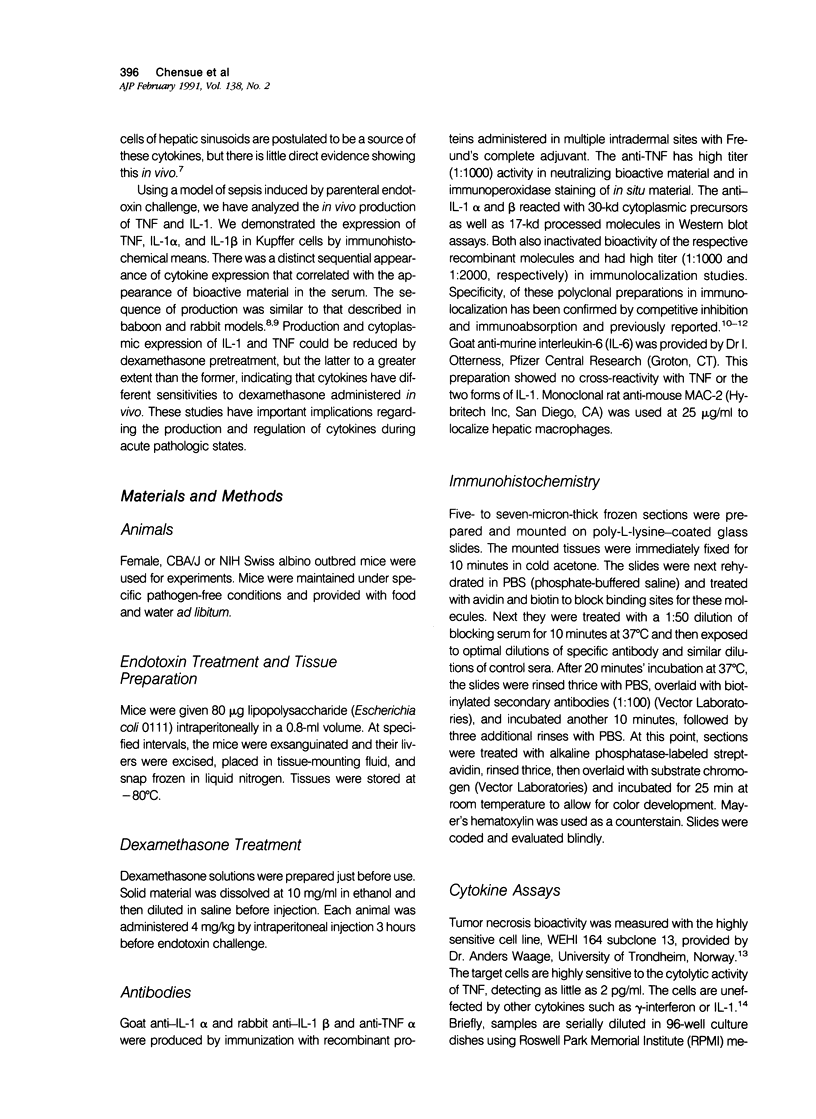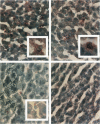Abstract
Using a model of sepsis induced by parenteral challenge of mice with bacterial lipopolysaccharide (LPS), the authors analyzed the in vivo expression of interleukin-1 (IL-1) alpha,beta and tumor necrosis factor (TNF). Both TNF and IL-1 alpha,beta were detected in hepatic sinusoidal macrophages (Kupffer cells), immunohistochemically. Kinetic analysis showed a clear sequence of synthesis. Tumor necrosis factor was produced first, reaching maximal expression at 1 hour after LPS challenge, then rapidly disappeared. IL-1 beta followed, reaching maximal expression at 2 to 3 hours, then dropped off by 6 hours. Interleukin-1 alpha expression reached a peak at 6 hours and had disappeared by 18 hours. Analysis of serum bioactivity also revealed sequential expression that correlated with immunohistochemical findings. Tumor necrosis factor was maximal at 1 hour and IL-1 at 6 hours. The IL-1 bioactivity was not due to interleukin-6 (IL-6), as this was depleted from specimens by immunoabsorption. Also IL-6 bioactivity reached maximal levels at 3 hours, earlier than IL-1. Pretreatment with 4 mg/kg dexamethasone significantly decreased Kupffer cell expression of TNF and IL-1 alpha (about 80% and 60% suppression, respectively) but had less effect on IL-1 beta expression (about 30% suppression). Accordingly, serum levels of TNF were suppressed by 75% while serum IL-1 was decreased by 39%, indicating differential sensitivity of these cytokines to glucocorticoids. Endogenous corticosteroid levels increased as TNF levels decreased, supporting the contention that glucocorticoids regulate TNF synthesis. In contrast, IL-1 levels rose concurrently with corticosterone. These data indicate a sequential activation of cytokine gene expression in vivo, which may be critical to the cascade of events leading to septic shock, and provide evidence that Kupffer cells are a major source of cytokines in endotoxemia. Finally, the differential sensitivity of cytokine expression to glucocorticoids may in part explain the inadequacy of the latter in the treatment of sepsis.
Full text
PDF







Images in this article
Selected References
These references are in PubMed. This may not be the complete list of references from this article.
- Besedovsky H., del Rey A., Sorkin E., Dinarello C. A. Immunoregulatory feedback between interleukin-1 and glucocorticoid hormones. Science. 1986 Aug 8;233(4764):652–654. doi: 10.1126/science.3014662. [DOI] [PubMed] [Google Scholar]
- Beutler B., Krochin N., Milsark I. W., Luedke C., Cerami A. Control of cachectin (tumor necrosis factor) synthesis: mechanisms of endotoxin resistance. Science. 1986 May 23;232(4753):977–980. doi: 10.1126/science.3754653. [DOI] [PubMed] [Google Scholar]
- Bone R. C., Fisher C. J., Jr, Clemmer T. P., Slotman G. J., Metz C. A., Balk R. A. A controlled clinical trial of high-dose methylprednisolone in the treatment of severe sepsis and septic shock. N Engl J Med. 1987 Sep 10;317(11):653–658. doi: 10.1056/NEJM198709103171101. [DOI] [PubMed] [Google Scholar]
- Chensue S. W., Remick D. G., Shmyr-Forsch C., Beals T. F., Kunkel S. L. Immunohistochemical demonstration of cytoplasmic and membrane-associated tumor necrosis factor in murine macrophages. Am J Pathol. 1988 Dec;133(3):564–572. [PMC free article] [PubMed] [Google Scholar]
- Chensue S. W., Shmyr-Forsch C., Otterness I. G., Kunkel S. L. The beta form is the dominant interleukin 1 released by murine peritoneal macrophages. Biochem Biophys Res Commun. 1989 Apr 14;160(1):404–408. doi: 10.1016/0006-291x(89)91670-7. [DOI] [PubMed] [Google Scholar]
- Chensue S. W., Shmyr-Forsch C., Weng A., Otterness I. G., Kunkel S. L. Biologic and immunohistochemical analysis of macrophage interleukin- 1 alpha, - 1 beta, and tumor necrosis factor production during the peritoneal exudative response. J Leukoc Biol. 1989 Dec;46(6):529–537. doi: 10.1002/jlb.46.6.529. [DOI] [PubMed] [Google Scholar]
- Eskandari M. K., Nguyen D. T., Kunkel S. L., Remick D. G. WEHI 164 subclone 13 assay for TNF: sensitivity, specificity, and reliability. Immunol Invest. 1990 Feb;19(1):69–79. doi: 10.3109/08820139009042026. [DOI] [PubMed] [Google Scholar]
- Espevik T., Nissen-Meyer J. A highly sensitive cell line, WEHI 164 clone 13, for measuring cytotoxic factor/tumor necrosis factor from human monocytes. J Immunol Methods. 1986 Dec 4;95(1):99–105. doi: 10.1016/0022-1759(86)90322-4. [DOI] [PubMed] [Google Scholar]
- Fong Y., Tracey K. J., Moldawer L. L., Hesse D. G., Manogue K. B., Kenney J. S., Lee A. T., Kuo G. C., Allison A. C., Lowry S. F. Antibodies to cachectin/tumor necrosis factor reduce interleukin 1 beta and interleukin 6 appearance during lethal bacteremia. J Exp Med. 1989 Nov 1;170(5):1627–1633. doi: 10.1084/jem.170.5.1627. [DOI] [PMC free article] [PubMed] [Google Scholar]
- Helle M., Boeije L., Aarden L. A. IL-6 is an intermediate in IL-1-induced thymocyte proliferation. J Immunol. 1989 Jun 15;142(12):4335–4338. [PubMed] [Google Scholar]
- Koopman W. J., Farrar J. J., Fuller-Bonar J. Evidence for the identification of lymphocyte activating factor as the adherent cell-derived mediator responsible for enhanced antibody synthesis by nude mouse spleen cells. Cell Immunol. 1978 Jan;35(1):92–98. doi: 10.1016/0008-8749(78)90129-6. [DOI] [PubMed] [Google Scholar]
- Larrick J. W., Kunkel S. L. The role of tumor necrosis factor and interleukin 1 in the immunoinflammatory response. Pharm Res. 1988 Mar;5(3):129–139. doi: 10.1023/a:1015904721223. [DOI] [PubMed] [Google Scholar]
- Lew W., Oppenheim J. J., Matsushima K. Analysis of the suppression of IL-1 alpha and IL-1 beta production in human peripheral blood mononuclear adherent cells by a glucocorticoid hormone. J Immunol. 1988 Mar 15;140(6):1895–1902. [PubMed] [Google Scholar]
- Mizel S. B., Oppenheim J. J., Rosenstreich D. L. Characterization of lymphocyte-activating factor (LAF) produced by the macrophage cell line, P388D1. I. Enhancement of LAF production by activated T lymphocytes. J Immunol. 1978 May;120(5):1497–1503. [PubMed] [Google Scholar]
- Morrissey P. J., Charrier K., Alpert A., Bressler L. In vivo administration of IL-1 induces thymic hypoplasia and increased levels of serum corticosterone. J Immunol. 1988 Sep 1;141(5):1456–1463. [PubMed] [Google Scholar]
- Okusawa S., Gelfand J. A., Ikejima T., Connolly R. J., Dinarello C. A. Interleukin 1 induces a shock-like state in rabbits. Synergism with tumor necrosis factor and the effect of cyclooxygenase inhibition. J Clin Invest. 1988 Apr;81(4):1162–1172. doi: 10.1172/JCI113431. [DOI] [PMC free article] [PubMed] [Google Scholar]
- Okusawa S., Yancey K. B., van der Meer J. W., Endres S., Lonnemann G., Hefter K., Frank M. M., Burke J. F., Dinarello C. A., Gelfand J. A. C5a stimulates secretion of tumor necrosis factor from human mononuclear cells in vitro. Comparison with secretion of interleukin 1 beta and interleukin 1 alpha. J Exp Med. 1988 Jul 1;168(1):443–448. doi: 10.1084/jem.168.1.443. [DOI] [PMC free article] [PubMed] [Google Scholar]
- Ramadori G., Van Damme J., Rieder H., Meyer zum Büschenfelde K. H. Interleukin 6, the third mediator of acute-phase reaction, modulates hepatic protein synthesis in human and mouse. Comparison with interleukin 1 beta and tumor necrosis factor-alpha. Eur J Immunol. 1988 Aug;18(8):1259–1264. doi: 10.1002/eji.1830180817. [DOI] [PubMed] [Google Scholar]
- Remick D. G., Strieter R. M., Eskandari M. K., Nguyen D. T., Genord M. A., Raiford C. L., Kunkel S. L. Role of tumor necrosis factor-alpha in lipopolysaccharide-induced pathologic alterations. Am J Pathol. 1990 Jan;136(1):49–60. [PMC free article] [PubMed] [Google Scholar]
- Remick D. G., Strieter R. M., Lynch J. P., 3rd, Nguyen D., Eskandari M., Kunkel S. L. In vivo dynamics of murine tumor necrosis factor-alpha gene expression. Kinetics of dexamethasone-induced suppression. Lab Invest. 1989 Jun;60(6):766–771. [PubMed] [Google Scholar]
- Scales W. E., Chensue S. W., Otterness I., Kunkel S. L. Regulation of monokine gene expression: prostaglandin E2 suppresses tumor necrosis factor but not interleukin-1 alpha or beta-mRNA and cell-associated bioactivity. J Leukoc Biol. 1989 May;45(5):416–421. [PubMed] [Google Scholar]
- Shirahama M., Ishibashi H., Tsuchiya Y., Kurokawa S., Okumura Y., Niho Y. Kinetics and parameters of the induction of interleukin 1 secretion by rat Kupffer cells. J Clin Lab Immunol. 1988 Nov;27(3):127–132. [PubMed] [Google Scholar]
- Starnes H. F., Jr, Warren R. S., Jeevanandam M., Gabrilove J. L., Larchian W., Oettgen H. F., Brennan M. F. Tumor necrosis factor and the acute metabolic response to tissue injury in man. J Clin Invest. 1988 Oct;82(4):1321–1325. doi: 10.1172/JCI113733. [DOI] [PMC free article] [PubMed] [Google Scholar]
- Tracey K. J., Fong Y., Hesse D. G., Manogue K. R., Lee A. T., Kuo G. C., Lowry S. F., Cerami A. Anti-cachectin/TNF monoclonal antibodies prevent septic shock during lethal bacteraemia. Nature. 1987 Dec 17;330(6149):662–664. doi: 10.1038/330662a0. [DOI] [PubMed] [Google Scholar]
- Waage A., Brandtzaeg P., Halstensen A., Kierulf P., Espevik T. The complex pattern of cytokines in serum from patients with meningococcal septic shock. Association between interleukin 6, interleukin 1, and fatal outcome. J Exp Med. 1989 Jan 1;169(1):333–338. doi: 10.1084/jem.169.1.333. [DOI] [PMC free article] [PubMed] [Google Scholar]
- Waage A., Halstensen A., Shalaby R., Brandtzaeg P., Kierulf P., Espevik T. Local production of tumor necrosis factor alpha, interleukin 1, and interleukin 6 in meningococcal meningitis. Relation to the inflammatory response. J Exp Med. 1989 Dec 1;170(6):1859–1867. doi: 10.1084/jem.170.6.1859. [DOI] [PMC free article] [PubMed] [Google Scholar]
- Zuckerman S. H., Bendele A. M. Regulation of serum tumor necrosis factor in glucocorticoid-sensitive and -resistant rodent endotoxin shock models. Infect Immun. 1989 Oct;57(10):3009–3013. doi: 10.1128/iai.57.10.3009-3013.1989. [DOI] [PMC free article] [PubMed] [Google Scholar]
- Zuckerman S. H., Shellhaas J., Butler L. D. Differential regulation of lipopolysaccharide-induced interleukin 1 and tumor necrosis factor synthesis: effects of endogenous and exogenous glucocorticoids and the role of the pituitary-adrenal axis. Eur J Immunol. 1989 Feb;19(2):301–305. doi: 10.1002/eji.1830190213. [DOI] [PubMed] [Google Scholar]



